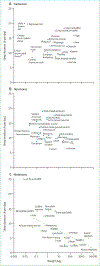Sleep function: an evolutionary perspective
- PMID: 36115365
- PMCID: PMC9670796
- DOI: 10.1016/S1474-4422(22)00210-1
Sleep function: an evolutionary perspective
Abstract
Prospective epidemiological studies in industrial societies indicate that 7 h of sleep per night in people aged 18 years or older is optimum, with higher and lower amounts of sleep predicting a shorter lifespan. Humans living a hunter-gatherer lifestyle (eg, tribal groups) sleep for 6-8 h per night, with the longest sleep durations in winter. The prevalence of insomnia in hunter-gatherer populations is low (around 2%) compared with the prevalence of insomnia in industrial societies (around 10-30%). Sleep deprivation studies, which are done to gain insights into sleep function, are often confounded by the effects of stress. Consideration of the duration of spontaneous daily sleep across species of mammals, which ranges from 2 h to 20 h, can provide important insights into sleep function without the stress of deprivation. Sleep duration is not related to brain size or cognitive ability. Rather, sleep duration across species is associated with their ecological niche and feeding requirements, indicating a role for wake-sleep balance in food acquisition and energy conservation. Brain temperature drops from waking levels during non-rapid eye movement (non-REM) sleep and rises during REM sleep. Average daily REM sleep time of homeotherm orders is negatively correlated with average body and brain temperature, with the largest amount of REM sleep in egg laying (monotreme) mammals, moderate amounts in pouched (marsupial) mammals, lower amounts in placental mammals, and the lowest amounts in birds. REM sleep might, therefore, have a key role in the regulation of temperature and metabolism of the brain during sleep and in the facilitation of alert awakening.
Copyright © 2022 Elsevier Ltd. All rights reserved.
Conflict of interest statement
Declaration of interests I declare no competing interests.
Figures





Comment in
-
How and why do human beings sleep?Lancet Neurol. 2022 Oct;21(10):862-864. doi: 10.1016/S1474-4422(22)00288-5. Lancet Neurol. 2022. PMID: 36115350 No abstract available.
References
-
- McNew JJ, Burson RC, Hoshizaki T, Adey WR. Sleep-wake cycle of an unrestrained isolated chimpanzee under entrained and free running conditions. Aerosp Med 1972; 43: 155–61. - PubMed
-
- Carskadon MA, Dement WC. Normal human sleep. In: Kryger MH, Roth T, Dement WC, eds. Principles and practice of sleep medicine, 4th edn. Philadelphia, PA: W.B. Saunders, 2005: 13–23.

